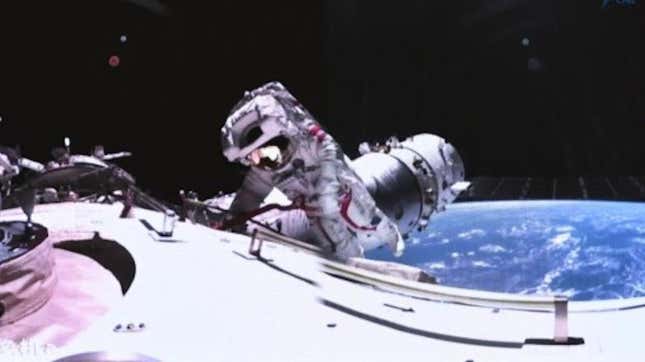China’s area station crew carried out two spacewalks this previous winter to restore the photo voltaic wings connected to the core module, which had been broken by area particles.
The Tiangong area station’s core module, Tianhe, suffered a partial lack of energy as a result of influence, main China to dispatch its astronauts on a pair of spacewalks for orbital repairs. The current spacewalks had been historic, marking the primary time China’s astronauts needed to conduct restore work in orbit. Because the state-run media outlet Xinhua now stories, these repairs had been profitable, fixing the core module’s photo voltaic wings.
The Shenzhou 17 crew members—astronauts Tang Hongbo, Tang Shengjie, and Jiang Xinlin—spent almost 16 hours tethered to the area station through the two spacewalks, the primary on December 1, 2023, and the second on March 1, 2024, in keeping with the China Manned Area Company (CMSA). The area station’s photo voltaic arrays at the moment are totally purposeful, in keeping with Xinhua, noting that the injury resulted from the “influence of area particles on the photo voltaic wing’s energy cables.”

It’s not clear when the influence to the area station came about, or what precisely might need struck the photo voltaic arrays. Provided that the primary spacewalk occurred in December, it’s seemingly the influence occurred shortly earlier than then. It could have been a pure incidence of a micrometeorite in orbit, or the results of human-spawned area junk.
China’s Tiangong area station has executed a number of maneuvers to keep away from area particles, Lin Xiqiang, deputy director of CMSA, stated throughout a current press convention, as Xinhua stories. The most recent incident has prompted the Chinese language area company to undertake preventative measures to mitigate the dangers of area particles. An upcoming mission to the station will convey alongside “area particles safety reinforcements for extravehicular piping, cables and important gear throughout their extravehicular actions,” in keeping with Xinhua.
In response to Lin, the area company has improved its capability to foretell the orbits of the area station and surrounding objects, refined the procedures for area collision warnings and avoidance maneuvers, and minimize the false alarm charge by 30 %, Xinhua reported. CMSA will even use the high-definition digital camera on the area station’s robotic arm, and the extravehicular hand-held cameras utilized by the astronauts, to examine Tiangong from the surface and analyze the chance of small particles impacts.
The dangers posed by area particles in orbit are rising as extra spacecraft are launched, rising the chance of orbital collision. Earlier this 12 months, a defunct Russian satellite tv for pc got here inside 10 meters of NASA’s TIMED spacecraft, which might have resulted in hundreds extra of area particles fragments floating in orbit.
For extra spaceflight in your life, comply with us on X and bookmark Gizmodo’s devoted Spaceflight web page.












Leave a Comment